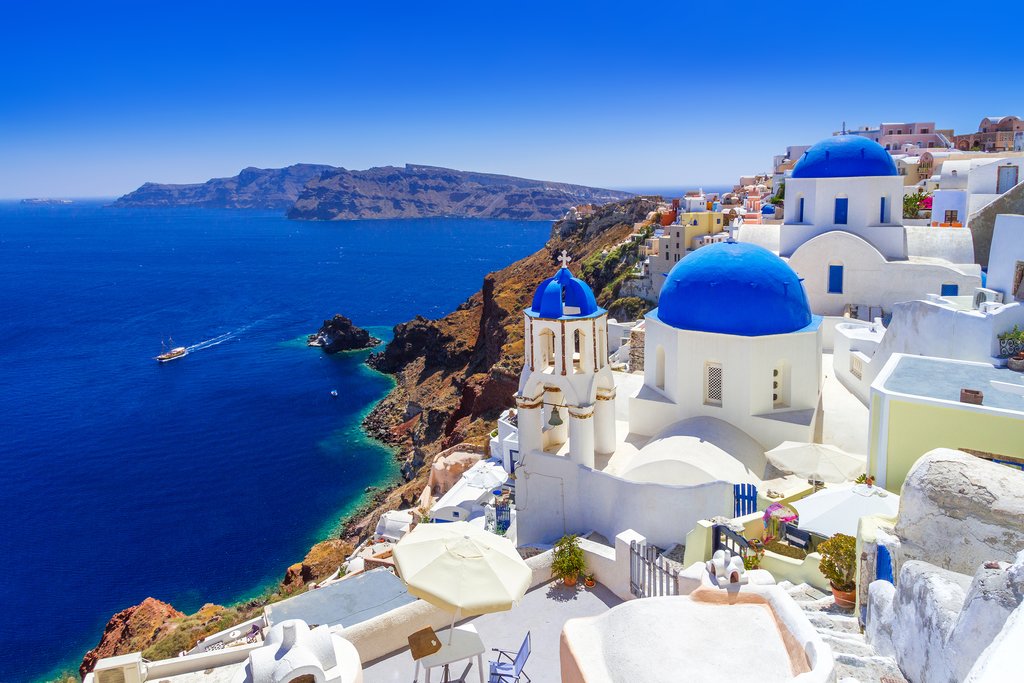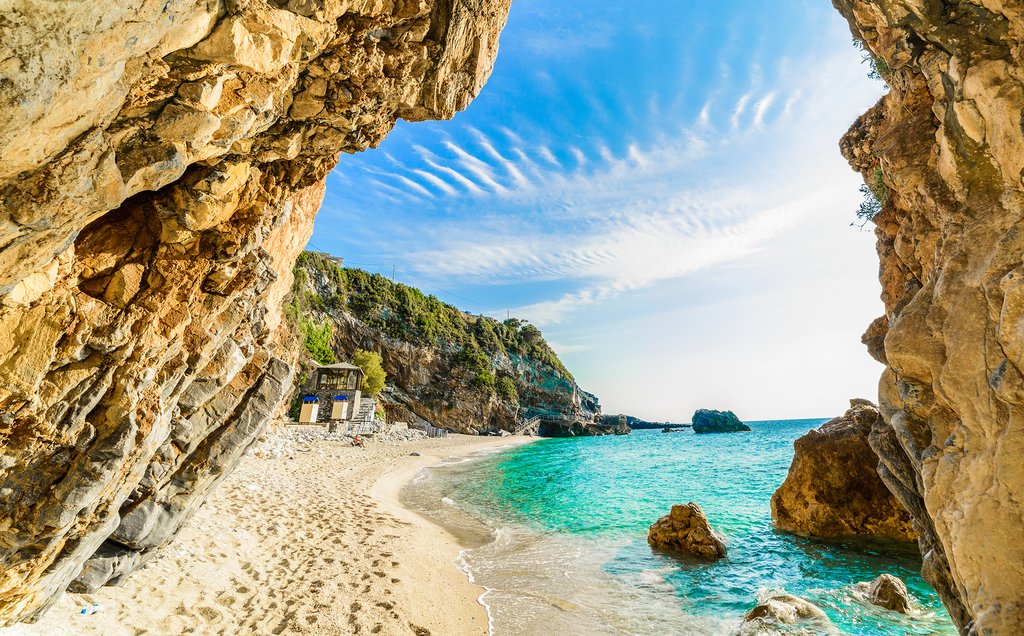Planning Your Trip
The best way to hop between islands is via one of the many ferry boats and hydrofoils (speedboats) that make frequent trips around the archipelago. Flying is not a practical option—you'd need to make a stop in Athens between islands, and not all islands even have airports—so most travelers should plan on using the ferry system. It's good to note that ferry schedules are subject to change, especially when there's inclement weather, so double-check before you go.
How many islands can you visit? That depends on the length of your trip. With a week, you can comfortably get to know two different islands. This 7-day itinerary features Naxos and Ios, lesser-known gems of the Cyclades, while this example focuses on famous Mykonos and Santorini. Add a week, and you can realistically hop between 3 or 4 islands. Check out this 14-day itinerary that combines three islands—Santorini, Naxos, and Mykonos—with some quality time in Athens. Crete has enough to do and see that it deserves a week of its own, or pair it with two other islands for a 14-day adventure—this example combines Crete with Tinos and Naxos for a well-rounded active adventure.
Keep in mind that the Greek islands are incredibly busy (read: crowded) from July through September, not so coincidentally a very pleasant time to visit. (See more on when to visit Greece here.) You'll want to book ferry tickets and accommodation as far in advance as you can.
Classic Island Charm in the Cyclades

You've seen these views in photos: white-washed houses, cats lying in the sun, pale cliffs jutting out of a deep blue sea. Now it's time to enjoy the classic pleasures of Greek islands in person on the Cycladic Islands, also known as the Cyclades. Southeast of the mainland, this island group comprises hundreds of islands (most are uninhabited) that form the shape of a circle around Delos, a sacred island that's considered one of the most important archaeological sites in the world. Indeed, ancient Greek philosophers named the islands Cyclades because of that shape: kyklos means "circle."
By far the most popular destinations in the region are postcard-perfect Santorini, known for its winemaking traditions, and beautiful Mykonos, which doubles as the gateway to Delos. Tinos is known for its long history of sculpting, and Milos for its otherworldly rock formations.
Go Car-Free on the Saronic Islands

You'll have to take a boat to get there, and then a donkey to get around: Hydra, one of the Saronic Islands, doesn't allow any cars. (There's one exception, luckily: garbage trucks are permitted.) The absence of motor vehicles lends an old-world charm and a slower pace to this increasingly popular destination.
But there's plenty more to explore in this island group. Also called the Saronic Gulf Islands or Argosaronikos, they're the closest to Athens, and a couple of them — Aegina and Agistri — are located just an hour or less away from the capital city by high-speed boat. You'll feel far away from civilization when you're cycling around the quiet island of Spetses or wandering around temples on Aegina. Just try to go on a weekday instead of a weekend, when Athenians day-trip from the city.
Chat with a local specialist who can help organize your trip.
Mountains and Mythology on the Ionian Islands

The lovely island of Corfu is widely considered to the inspiration for the setting of The Tempest, Shakespeare's final play. There's no doubt the landscape, with its vibrant foliage, mountainous roads, abundant olive groves, and jaw-dropping sea views, could be the basis for a great work of literature.
Sleepy Corfu is one of the Ionian Islands (also known as the Heptanese), the island group that's closest to Italy and Albania. These islands have been ruled, at turns, by Venetians, Romans, Russians, French, and Austrians, to name just a few, and the diverse architectural styles you'll see in the islands' villages are a testament to that colorful history.
Sunbathe on a sandy cove or hike around limestone cliffs on Kefalonia, go for a kayak adventure in the Ionian Sea, rent a car and go for a self-guided adventure around Corfu, or explore the roots of Greek mythology on Ithaca.
Check out this eight-day itinerary sailing the Ionian Sea from Corfu.
Discover a Local Escape in the Sporades

Where do Athenians go when they want to get out of town? The Sporades Islands, located off the coast just east of the city. There's a charming story behind the name. According to legend, the gods created the islands by throwing handfuls of colored pebbles into the Aegean Sea: "Sporades" means "the scattered ones."
There's still lots of color on beautiful islands like Skiathos, known for the brilliant blue water of its sandy beaches, and the lush green landscapes of Skyros. You don't even have to get on a boat or a plane to access the large island of Evia: it's connected to mainland Greece by a bridge.
Architectural Wonders of the Dodecanese

Close to Turkey in the southeastern Aegean Sea, the Dodecanese Islands weren't always part of Greece. For a great part of history, through World War II, they were under Ottoman and then Venetian rule. That fact is evident in the eclectic architectural styles on view on the islands' towns and villages.
Most visitors make a beeline for the island of Rhodes, with an impressive medieval old town that's considered the historic capital of the island group. Don't miss the Street of the Knights, a road that looks just as it would have in the Middle Ages, leading to the magnificent Palace of the Grand Masters. Wandering around the old town, you'll see ancient marble statues and fountains, plus ornate mosques and hammams that remind you of the city's Ottoman heritage.
Elsewhere on islands like Karpathos and Kalymnos, there are beaches galore, and ideal weather for relaxing on them: the Dodecanese are known as the sunniest islands in Greece.
Get Away From the Crowds on the North Aegean Islands

The North Aegean Islands aren't as easily accessible as some of the other Greek island groups—and that's precisely what makes a visit here so pleasurable. You'll have the towns, castles, monasteries, and other noteworthy spots largely to yourself. Key attractions include the island of Lesvos (also spelled Lesbos), home to a petrified forest and the national capital of ouzo, Greece's favorite spirit.
On the island of Chios, a spectacular medieval settlement awaits intrepid travelers. The village of Mestá is a maze: towers, churches, and stone houses are all built tightly together, with the roods interconnected. It's a magical place to wander through, as if you were stepping back in time.
For more on Chios, Lesvos, and other destinations travelers often miss in Greece (but shouldn't), check out this article.
Explore Ruins and Villages on the Island of Crete

The largest island in Greece, Crete is a destination that's worth a whole vacation on its own. It's an island that truly has it all: nature, food, tradition, and beautiful coastal towns. Minoans, the earliest advanced European civilization made their home here—predating the ancient Greeks—so there's also plenty to see in terms of historic ruins.
Visitors will want to beeline to the beach at Elafonisi and take a hike through stunning Samaria Gorge, one of the longest gorges in Europe. In the White Mountains, pay a visit to Ideon Cave — it's the birthplace of Zeus, according to Greek mythology. Working up an appetite with so much fresh air and exercise? Treat yourself to a glass of wine, fresh bread, locally produced olive oil, and more—this 6-day culinary tour is an option for gastronomy-minded travelers.
